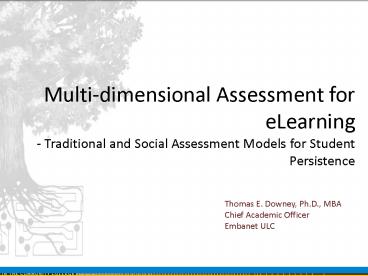Multidimensional Assessment for eLearning Traditional and Social Assessment Models for Student Persi - PowerPoint PPT Presentation
1 / 18
Title:
Multidimensional Assessment for eLearning Traditional and Social Assessment Models for Student Persi
Description:
Thomas E. Downey, Ph.D., MBA. Chief Academic Officer. Embanet ULC ... Embanet partners with Universities to bring their programs online. Over 53 programs launched ... – PowerPoint PPT presentation
Number of Views:114
Avg rating:3.0/5.0
Title: Multidimensional Assessment for eLearning Traditional and Social Assessment Models for Student Persi
1
Multi-dimensional Assessment for eLearning-
Traditional and Social Assessment Models for
Student Persistence
Thomas E. Downey, Ph.D., MBA Chief Academic
Officer Embanet ULC
2
Urgency About Student Persistence
- Embanet partners with Universities to bring their
programs online - Over 53 programs launched
- Over 750 courses developed
- Over 20 Knowledge Partners
- Economics of eLearning - Student Persistence is
a shared goal between universities and business - Quality of the learning environment
- High graduation rate
- Increased revenue
3
A Few of Our Education Partners
4
- Student Retention
- students are more likely to persist when they
find themselves in settings that hold high
expectations for their learning, provide needed
academic and social support, and actively involve
them with other students and faculty in learning.
The key concept is that of educational community
and the capacity of institutions to establish
educational communities that involve all students
as equal members. - - Tinto, 2002
5
Tintos Persistence Research
6
Student Persistence
- eLearning historically has a high drop-out rate
/ low persistence - You cant manage what you cant measure
- Measurements are needed to allow us to track and
intervene in a timely manner. - Longitudinal measures are needed for long term
Continuous Quality Improvement (CQI) and
accreditation data. - Timely data where interventions and improvements
can yield positive results for students - Multiple measures at multiple levels yielding
actionable recommendations
7
Student Persistence Measurement
- The eLearning environment presents unique
challenges in assessment - Pedagogical methods have changed
- Objectivist vs. Constructivist Teacher vs.
Coach - Asynchronous vs. synchronous Time for
reflection - Individual vs. virtual group Communication and
PM - Virtual presence person-to-person and
person-to-group interaction Communities of
Inquiry (COI) - Traditional models are not sufficient
8
Relevant eLearning Assessment
- Assessment of elearners should more closely match
the environment that they will use for their
professional careers - eLearners must interact in disassociated
environments - Community is virtual, temporary, focus on task is
tight, time schedules are short, teamwork and
communication skills are critical - Everyone must contribute and collaborate
- How do we assess this today?
9
Defining Student Persistence
- Community of Inquiry (CoI) (Swan, Richardson
et.al., 2007) - Social Presence
- Cognitive Presence
- Teaching Presence
- Entrepreneurial Learner of the 21st Century
(Reimers, King, et.al, 2005) - Internal Locus of Control (LOC)
- High need for achievement
- Moderate risk-taking propensity
- Interaction in Courses (Chickering and Ehrmann
1996) - Instructor involvement / feedback / student
interaction - Drives longer persistence in course / program
- Emotional Intelligence (Berenson, Boyles,
et.al.,2008) - Learners emotional response to the learning
environment - Self-awareness of ones own feelings / needs
10
Missing Dimensions
- We must measure effectiveness of the total
learning environment not limited to the course - We need an inclusive and comprehensive assessment
model - Above the course level to the enterprise level
- A systematic / proven approach
- Look to business / IT
- Service Level Agreements (SLAs)
- Quality of Service (QOS)
- Continuous Quality Improvement (CQI)
11
Missing Assessment Dimensions
- We require measurements for a dynamic eLearning
system mirroring the virtual work environment - Group work how do we create a fair model of
assessment - 360 degree assessments
- Longitudinal assessment - measuring goal
completion - ePortfolios with feedback from the instructor
- Reflections on learning activities
12
Sources of Multi-Dimensional Data
- Students
- Program Administrators
- Student Services Advisors
- Technical Support Services
- Service logs / types of issues / resolution
- Instructional Designers
- Instructors
- Facilitators
- Student grades
13
Multi-Dimensional Data Gathering
- Multi-Part and Multi-Role Surveys
- Web-based Survey Software
- Common core of questions / differentiated
questions by role - Survey Participants
- Students
- Instructors / Facilitators
- Instructional Designers
- Program Administrators
- Student Services Advisors
- Student Grades
- Technical Support Logs
14
Levels for Reporting
Longitudinal Reports / Measurements Over Time
Enterprise Level
Program Level
Course Level
Student Level
15
Sources of Data by Level
Longitudinal Reports / Measurements Over Time
eScore Card - Course / Program / ePortfolios /
Changes Implemented effect on scores
Enterprise Level
System Support up time, types of issues
Program Level
Program Administrators, Students
Course Level
Students, Facilitators, Instructors, Student
Services, Student Grades
Student Level
End of Course Critique, Grades, Time on Task,
Involvement / Interaction
16
Benefits of These Reports
Longitudinal Reports / Measurements Over Time
CQI and QOS - Over Time, Accreditation Data,
Repositories of Exemplar Work
Enterprise Level
Systems Performance, Technical Support, Student
Entry Level need for training
Program Level
Administrator Satisfaction (Program Goal
Attainment), Student Persistence
Course Level
Ss Performance, Design of Course, Persistence,
Effectiveness of Course / Ss Support
Student Level
Student Involvement / Interaction / Affect /
Satisfaction
17
M-D Assessment Project Status
- Project Partners Identified
- Multi-part survey in testing
- Tech Support log summary reports completed
- Next Steps
- Field test data gathering with live data
- Create test reports
- Review with Knowledge Partners for Completeness
and Accuracy - Roll out to larger segment of Knowledge Partners
- Incorporate into Suite of Value Added Features
from Embanet
18
Thank You.

